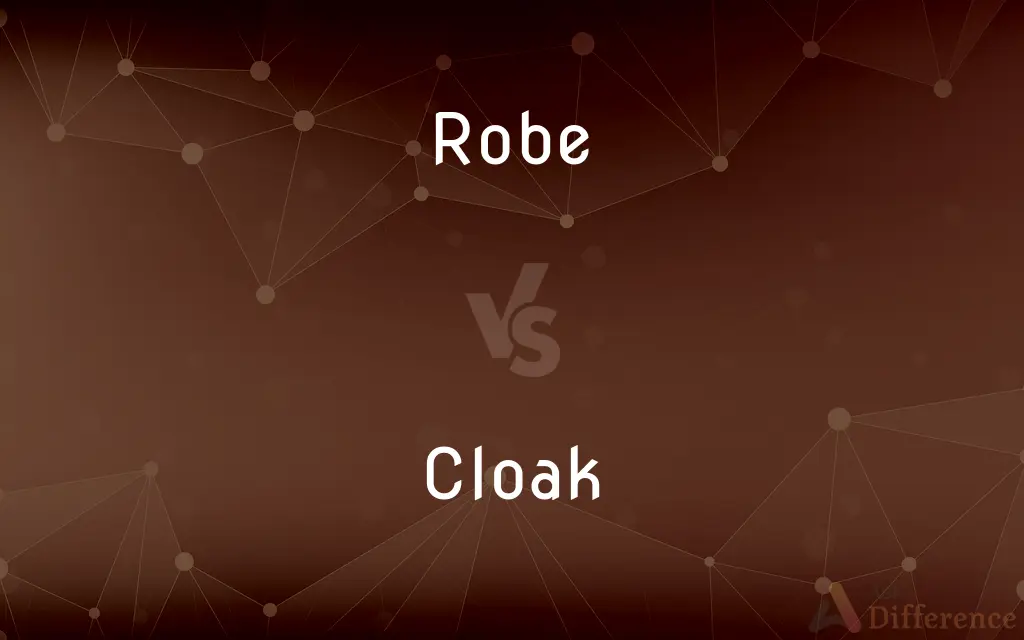Robe vs. Cloak — What's the Difference?
By Tayyaba Rehman & Maham Liaqat — Updated on April 1, 2024
A robe is a loose-fitting outer garment often associated with formal or ceremonial occasions, while a cloak is a flowing outer garment without sleeves, typically worn for warmth or protection.

Difference Between Robe and Cloak
Table of Contents
ADVERTISEMENT
Key Differences
Robes are usually full-length garments that cover the body from the shoulders down, often worn for specific purposes such as religious ceremonies, academic graduations, or lounging at home. They may be made from a variety of materials, including silk for luxury or cotton for comfort. On the other hand, cloaks are outer garments designed to be worn over other clothing for warmth or protection from the weather. They wrap around the body and are fastened at the neck, usually extending to the knees or lower, and are often equipped with a hood.
While robes are often associated with specific roles or statuses, indicating authority, professionalism, or ceremonial significance, cloaks are more utilitarian, designed for practicality in outdoor environments. Cloaks provide a layer of warmth and can offer protection from rain or snow, making them popular in historical contexts and fantasy literature.
The design of robes can vary widely depending on their intended use, with some featuring elaborate decorations, symbols, or colors indicative of their significance. Cloaks, while they can also be ornamental, are generally simpler in design, focusing on functionality with the possible addition of a hood for extra protection.
Robes have a rich cultural and historical significance, serving as important symbols in various ceremonies and professions. They can denote rank, profession, or achievement, such as judges' robes or academic regalia. Cloaks, while also historical, are more closely associated with travel, adventure, and protection in the elements, embodying a sense of mystery or romance in literature and media.
In modern times, robes have remained prevalent in specific contexts where tradition and formality are observed, such as in judicial, academic, and religious settings. Cloaks, though less common in everyday wear, still appear in fashion, reenactments, and as part of costumes, retaining their appeal for their aesthetic and functional qualities.
ADVERTISEMENT
Comparison Chart
Primary Use
Formal, ceremonial, or personal comfort
Warmth and protection from the elements
Design
Loose-fitting, often with open front
Sleeveless, fastens at the neck
Length
Can vary, often full-length
Usually knee-length or longer
Associated With
Authority, professionalism, tradition
Travel, adventure, protection
Key Features
May include belts, decorations, specific colors
Often includes a hood for extra protection
Compare with Definitions
Robe
Clothing indicating a specific role or status, such as in religious contexts.
The priest donned his ceremonial robe for the service.
Cloak
A garment worn over other clothing for protection against the weather.
They donned rain cloaks to protect against the storm.
Robe
An outer garment that covers the majority of the body, used for various purposes.
He put on a warm robe to relax in the chilly evening.
Cloak
A cloak often includes a hood and is used for warmth or as a fashion statement.
Her elegant velvet cloak was both stylish and practical.
Robe
A long, loose outer garment worn for special occasions or ceremonies.
The judge wore a black robe to the courtroom.
Cloak
A sleeveless outer garment that drapes the wearer’s body, typically fastened at the neck.
She wore a heavy cloak to keep warm in the winter winds.
Robe
A garment worn for personal comfort, usually after bathing.
She wrapped herself in a soft robe after her shower.
Cloak
An item of clothing often associated with historical or fantasy settings.
The hero wrapped his cloak around him as he ventured into the night.
Robe
A garment of distinction used in academic settings, like graduations.
Graduates wore traditional robes during the commencement ceremony.
Cloak
A protective outer garment, simple in design but rich in history.
The traveler’s cloak was worn and frayed, a testament to many journeys.
Robe
A robe is a loose-fitting outer garment. Unlike garments described as capes or cloaks, robes usually have sleeves.
Cloak
A cloak is a type of loose garment that is worn over indoor clothing and serves the same purpose as an overcoat; it protects the wearer from the cold, rain or wind for example, or it may form part of a fashionable outfit or uniform. Cloaks have been used by myriad historic societies; many climates favor wearing a full-body garment which is easily removed and does not constrain the wearer with sleeves.
Robe
A long, loose outer garment reaching to the ankles
A baby in christening robes
A young man in a fez and ragged robe
Cloak
A sleeveless outdoor overgarment that hangs loosely from the shoulders
He threw his cloak about him
Robe
Short for lap robe
Cloak
A cloakroom
Ground-floor accommodation comprises hall, cloaks, lounge, kitchen
Robe
Clothe in a robe
A circle of robed figures
A white-robed Bedouin
Cloak
Dress in a cloak
They sat cloaked and hooded
Robe
Often robes An official garment worn on formal occasions to show office or rank, as by a judge or high church official.
Cloak
A long, loose outer garment, usually having a hood and no sleeves.
Robe
An academic gown.
Cloak
Something that covers or conceals
A cloak of secrecy.
Robe
A dressing gown or bathrobe.
Cloak
To cover or conceal with a cloak or something that acts like a cloak
Mist that cloaks the mountains.
Robe
Robes Clothes; apparel.
Cloak
A long outer garment worn over the shoulders covering the back; a cape, often with a hood.
Robe
A blanket or covering made of material, such as fur or cloth
A lap robe.
Cloak
A blanket-like covering, often metaphorical.
Night hid her movements with its cloak of darkness.
Robe
To cover or dress in a robe or in something that functions like a robe
Fields that were robed with snow.
Cloak
(figurative) That which conceals; a disguise or pretext.
RQ:South Twelve Sermons
Robe
To put on a robe or robes.
Cloak
(Internet) A text replacement for an IRC user's hostname or IP address, making the user less identifiable.
Robe
A long loose outer garment, often signifying honorary stature.
Cloak
(transitive) To cover as with a cloak.
Robe
(US) The skin of an animal, especially the bison, dressed with the fur on, and used as a wrap.
Cloak
To cover up, hide or conceal.
Robe
A wardrobe, especially one built into a bedroom.
Cloak
To render or become invisible via futuristic technology.
The ship cloaked before entering the enemy sector of space.
Robe
The largest and strongest tobacco leaves.
Cloak
A loose outer garment, extending from the neck downwards, and commonly without sleeves. It is longer than a cape, and is worn both by men and by women.
Robe
(transitive) To clothe; to dress.
Cloak
That which conceals; a disguise or pretext; an excuse; a fair pretense; a mask; a cover.
No man is esteemed any ways considerable for policy who wears religion otherwise than as a cloak.
Robe
(intransitive) To put on official vestments.
Cloak
To cover with, or as with, a cloak; hence, to hide or conceal.
Now glooming sadly, so to cloak her matter.
Robe
An outer garment; a dress of a rich, flowing, and elegant style or make; hence, a dress of state, rank, office, or the like.
Through tattered clothes small vices do appear;Robes and furred gowns hide all.
Cloak
Anything that covers or conceals
Robe
A skin of an animal, especially, a skin of the bison, dressed with the fur on, and used as a wrap.
Cloak
A loose outer garment
Robe
To invest with a robe or robes; to dress; to array; as, fields robed with green.
The sage Chaldeans robed in white appeared.
Such was his power over the expression of his countenance, that he could in an instant shake off the sternness of winter, and robe it in the brightest smiles of spring.
Cloak
Hide under a false appearance;
He masked his disappointment
Robe
Any loose flowing garment
Robe
Outerwear consisting of a long flowing garment used for official or ceremonial occasions
Robe
Clothe formally; especially in ecclesiastical robes
Common Curiosities
Do all robes signify a specific status or role?
Not all, but many robes are designed to signify a particular status, profession, or achievement.
How do the materials of robes and cloaks differ?
Robes can be made from a variety of materials from cotton to silk, based on their use. Cloaks are often made from heavier materials for warmth and protection.
What occasions are robes typically worn for?
Robes are worn for formal occasions, ceremonies, or for personal comfort and relaxation.
Are cloaks practical for everyday use?
While less common today, cloaks can be practical for outdoor use, providing warmth and protection from the elements.
Is a hood a common feature of cloaks?
Yes, many cloaks include a hood for added protection against the weather.
Do robes always have belts?
Many types of robes, especially those worn for personal comfort, include belts for securing them around the waist, but this is not universal.
How does the function of robes and cloaks differ?
Robes often serve a ceremonial, professional, or comfort function, while cloaks are primarily designed for warmth and protection.
What cultural significance do robes have?
Robes hold cultural significance in various contexts, such as religious ceremonies, judicial proceedings, and academic achievements.
Are cloaks still used for travel?
While not as common as they once were, cloaks can still be used for travel, especially in historical reenactments or by those seeking a traditional or aesthetic garment.
Can cloaks be worn in modern times?
Yes, cloaks can be worn for warmth, as part of costumes, or as a fashion statement.
Can a cloak have sleeves?
Traditionally, cloaks do not have sleeves; their defining feature is being sleeveless, but there are modern variations that may include sleeves for additional warmth.
What is the historical importance of cloaks?
Cloaks have been used throughout history for protection from the elements, and they hold a place in cultural and literary tradition as garments of travelers and adventurers.
How do the designs of robes and cloaks reflect their uses?
Robes often have open fronts and may include decorative elements for specific ceremonies, while cloaks are designed to be practical, with a focus on warmth and simplicity.
Can robes and cloaks be fashionable?
Yes, both robes and cloaks can be fashionable, depending on the design, material, and context in which they are worn.
Why might someone choose a robe over a cloak, or vice versa?
The choice depends on the intended use: a robe for formal, ceremonial, or comfort purposes, and a cloak for warmth and protection outdoors.
Share Your Discovery

Previous Comparison
Butler vs. Cook
Next Comparison
Cicada vs. CricketAuthor Spotlight
Written by
Tayyaba RehmanTayyaba Rehman is a distinguished writer, currently serving as a primary contributor to askdifference.com. As a researcher in semantics and etymology, Tayyaba's passion for the complexity of languages and their distinctions has found a perfect home on the platform. Tayyaba delves into the intricacies of language, distinguishing between commonly confused words and phrases, thereby providing clarity for readers worldwide.
Co-written by
Maham Liaqat













































